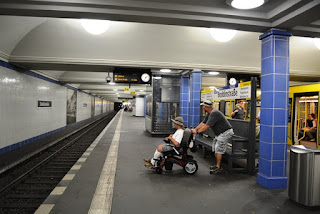(Please read our Covid 19 Statement first - Ed) Transit in Berlin and Munich, at least, is very accessible. More so than in many U.S. ADA-covered cities like New York or Chicago even.
We like to use trains (such as the U-Bahn subway system) as much as we can but also know that the buses are accessible, too. While we'll get to the trains and trams below but first, the bus.
Watch the Video!
Wave to flag the bus driver that you'll want to board the bus. You'll most likely enter via the rear door where a ramp can be deployed. A wheelchair section will be at mid bus, the correct position is to sit rear-facing against the bracing board. Many buses also have a strap that you can request the driver put across you for added security.
You can tell the driver where you want to exit or press the button with the wheelchair symbol next to the wheelchair section. This will let the driver know that a wheelchair needs to exit at the next stop.
On buses, as with trams, you will most likely purchase your fare ticket on board (there are a few spots, like the airport or larger train stations where you can buy the ticket ahead of time). Please note that just purchasing the ticket does not make it valid...you must validate it on the bus or tram (or ahead of time, if you have access to a validator) with the machine that stamps it with the time and date.
This ticket must be shown to fare inspectors upon demand, who will check the time and date to see if it is expired or not (fare is good for two hours on a basic single ride ticket).
In larger German cities, the U-Bahn and S-Bahn are the backbone of the system. It's equivalent to the subways and commuter trains of larger American Cities.
For the U-Bahn and S-Bahn, you must buy and validate a ticket before getting on the train. For all trains, buses, and trams, you can also buy multi-day passes.
Before riding on the U-Bahn or S-Bahn, it would be very helpful to check a subway system map to make sure the station you want to go to is wheelchair accessible. The system maps don't always show wheelchair symbols but they do have either an elevator icon, or a ramp icon indicating which type of access is available.
Berlin System Map
Munich System Map
If neither icon is showing, the station is not accessible to wheelchairs.
Most trams in both cities have either ramps or lifts into the vehicles. For any means of transit, the best place to wait is where the front of the train, tram, or bus will be so the driver can see you and deploy any ramps or lifts necessary.
All barrier-free (barrierefrie in German) stations have a folding ramp, so if you get a train with a gap that you cannot manage, the driver or station attendant is supposed to deploy that ramp for you.
For more information, please visit the respective websites below.
Berlin Public Transit
Munich Public Transit
Darryl Musick
Copyright 2016 - All Rights Reserved
Photos by Letty Musick
Copyright 2016 - All Rights Reserved




No comments:
Post a Comment